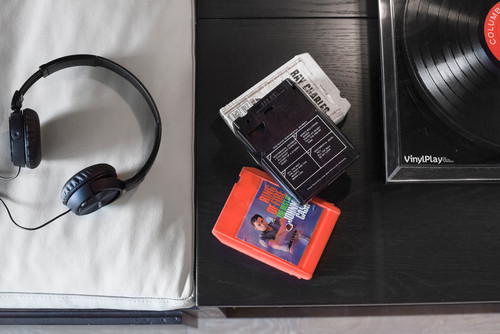Give This Holiday and Make Your Home Clutter-Free


Charitable organizations make it even easier for you to donate your household items this time of year.
Guest post by Laura McHolm
‘Tis the season of gratitude, giving and of course: decorating, parties, feasts, shopping and more. But before you go down your merry, merry to do list, think about the needs of your community and all the stuff and clutter you don’t need around your home. Perhaps, you have clothing, furniture, kitchen items, or even food you have been meaning to clear out? The jolly news is charitable organizations make it even easier for you to donate your household items to assist those in need this time of year. You can make a difference, so everyone can have a joyful holiday. And, you get to rediscover the holiday joy you experienced as a child.
This is not just another to do on your holiday list, it’s very simple and the rewards are immense – it’s the ultimate win- win! You assist others and at the same time you get a clutter-free home, all prepped for the holidays. No need to scramble to find a solution for outgrown clothes and furniture, and pantry items you will never use, simply follow this guide of “What to Give and Where to Give” and the process will be Grinch-free!
1. Non-Perishable Food
Make room for all of the yummy holiday goodies! Wondering if your food bank wants your three pound bottle of mustard? Here are the top items that they need:
- Canned Vegetables & Fruits
- Canned Stews & Soups
- Canned Beans
- Canned Tuna
- Pasta & Sauce
- Baby Food
- Dry Beans
- Flour
- Cereal & Oatmeal
- Juice
- Rice
- Peanut/Nut Butters & Jelly/Jams
Where to Donate:
- Your local Food Bank. You can find your local food bank here.
- Check with your local fire department, churches, synagogues, schools, and grocery stores to see if they are hosting food pantry donations drop offs
- Visit www.MoveForHunger.org, a non-profit organization that will connect you with a local moving company that will deliver your non-perishable food donations to your local food bank for you. Check out their Find A Mover tool.
- Willing to roll-up your sleeves? Start your own food drive. Simply ask local businesses, schools and libraries to put out your colorfully decorated food drive donation boxes and use your social networks to get the word out. It only takes 1.2lbs of food to provide a meal to an individual in need, so it doesn’t matter how big your food drive is, every little bit helps.
2. Clothing
Make room for your holiday sweaters! Bring gently used clothing to the following charities or go online or call them to see if they will come to your door to pick up your donations.
- Baby, kids and adult clothing
- Coats (Kids and families are in great need of coats this time of year.)
- Suits
- Belts
- Scarves
- Ties
- Pocketbooks
- Boots
- Shoes
Where to Donate:
- Goodwill
- Salvation Army
- Epilepsy Foundation
- Veteran organizations
- Big Brothers Big Sisters of America
- Red Cross
- Check with your local fire department, churches, synagogues and schools, to see if they are hosting clothing donation drop offs
3. Toys
Make room for what Santa brings! Get your kids involved in sorting through their things so they get to learn the ultimate gift – the gift of giving!
- Gently used, unbroken toys or new toys that are unwrapped (it depends on the charity if a new toy is required so contact them first.)
- Stuffed animals
- Coloring books & crayons
- School supplies and stationery
- Hand held games
- Children’s books
- No toy guns or other violent toys
Where to Donate:
- Toys for Tots. Find your local Toys for Tots drop off locations here.
- Local children’s hospitals & hospitals
- Local Ronald McDonald House. Find a local Ronald McDonald location or care mobile here.
- Local Boys & Girls Club
- Many local shelters or children’s charities accept toy donations. Use this Homeless Shelter Directory to find shelters in your area.
- Organizations like My Stuff Bags and Stuffed Animals for Emergencies offer children a familiar object in times of crisis.
- Check with your local fire department, churches, synagogues, and schools, to see if they are hosting toy donation drop offs
- Other places to check include a children’s social services office and even stores often have a donation bin at the front entrance where you can place donation
4. Household Goods & Furniture
Make room for your gifts!
- Antiques, collectibles
- Appliances (small)
- Artwork
- Bedspreads, blankets, curtains, tablecloths, decorative pillows
- Bicycles
- Books, records, tapes, CDs, DVDs
- Cookware, dishes, pots and pans
- Housewares and decorative items
- Jewelry
- Sporting goods
- Gently used furniture
Where to Donate:
- Habitat for Humanity ReStore
- Goodwill
- Salvation Army
- Epilepsy Foundation
- Veteran organizations
- Big Brothers Big Sisters of America
- Red Cross
5. Cell Phones
Clean out the old gadget drawer! Donate old smart phones & tablets (make sure to clear your data from it first!)
Where to Donate:
6. Gift Cards
Keep your drawers clutter free! Re-gift the gift cards you are given and turn them into charitable donations. Exchange your retail gift cards for a charity donation. You will receive a tax receipt for the entire full value or residual balance of your card.
Where to Donate:
- CharityGiftCertificates.org
7. Vehicles
Open up a parking space for Santa’s sleigh!
- Car
- Truck
- RV
- Boat
- Motorcycle
- Trailer
Where to Donate:
- Habitat for Humanity Cars for Homes
- Salvation Army
- Kars 4 Kids
- Wheels for Wishes
- Cars Helping Veterans.org
- Goodwill
Once you have cleared the clutter and given to those who will actually use and need your unwanted items, well, just like they say in Whoville, your heart will grow three sizes and the true meaning of the holidays will come through, plus two!
Source: CB Blue Matter Blog
5 Ways to Start 2018 Right in Your Home

 To get your home in tiptop shape for 2018, here are some important and efficient ways to get it ready.
To get your home in tiptop shape for 2018, here are some important and efficient ways to get it ready.
Guest post by Andrea Davis
2018 is almost here! While you might consider making some New Year’s resolutions, you first need to think about your end of the year list. To get your home in tiptop shape for 2018, here are some important and efficient ways to get it ready.
1. Clean, clean, CLEAN!
If you haven’t taken care of the essential house cleaning chores, now is the time. You’ll want to quickly or deeply clean many areas of your home. These include:
- Windows
- Linens
- Floors
- Cabinets/countertops
- Appliances
- Gutters & downspouts
- Air vents
Not only does this give your home a refreshed look, it also keeps you financially savvy going into 2018. Without the proper cleaning, areas like the air vents and gutters can lead to expensive home repair bills.
2. Purge & Recycle
Nobody likes looking at a full closet, especially if you have holiday presents to add. So go through every bit of storage in your home – closets, attic, basement, garage, shed, etc. – and remove what you don’t need. You can either throw it away or recycle it by donating to a local secondhand shop. That way, you have tons of space for next year’s discoveries.
3. Increase Efficiency
If you’re going through bills and notice a marked increase in utility costs, now is the time to plan out an efficient home in 2018. This could be as simple as turning off the lights more often and conserving water. On the other hand, if you have some extra dollars, you might consider improvements like:
- Double or triple-paned windows
- Solar panel(s)
- Upgrade your faucets and water outlets
4. HVAC TLC
One of the most important – and expensive – parts of your home is the HVAC system. It keeps the house warm in the winter and cool in the summer. Because it does so much work, it needs some fine-tuning and maintenance at least every six months. To make sure you avoid an expensive bill in 2018, go through the system. Replace the filter, clean out the vents and make sure it’s all working smoothly. If you aren’t an HVAC pro, you can find plenty in the neighborhood to come for a quick checkup.
5. Review the Exterior
Roofing, landscaping, doors, siding – have you given them a thorough look? All of these are important to a beautiful appearance and optimal safety. You need to check for cracks, holes, overhanging branches and the like. You can always get a home inspector for a more in-depth review, but most of it you can do yourself. Doing a quick circle around the house with some spackle or caulk works at least in the short term.
Conclusion
Going into 2018 means letting go of 2017’s hassles. To feel free of any stress, you should take care of the essentials, including your home. Maintenance and some cheap upgrades could make all the difference personally and financially in the New Year. Don’t feel you have to go all out, or else you’ll be too tired for new tasks. Make sure there’s a nice balance of work and play so you get the best start to 2018.
Source: CB Blue Matter Blog
Prevent a Holiday Disaster at Home With These 10 Must Read Tips


Keep Your Kids (2 legged and 4) safe this holiday season with these 10 tips from Northstar Moving Company!
NorthStar Moving Co-Founder Laura McHolm
There is no ignoring it now. The twinkling trees, tinsel and….attractive trouble are all around. Whether you are singing “Feliz Navidad” or “Dradle Dradle Dradle,” we can all agree this is one of the greatest times of the year, BUT it’s also filled with hidden dangers for your children and pets. In fact, it is one of the most dangerous times of the year for your dog Dasher, your cat Blitzen and your two legged crawlers. So, don’t let all the sparkle distract you, be sure to keep an eye out for festive trouble.
That’s why I called upon two experts to guide us through all of the dangers our holiday décor and holiday foods can create for our little loved ones. First, the child safety experts at Boo Boo Busters talk Santa safety with five key tips to keep your children safe:
- The Christmas Tree: We are all conscious of hanging the fragile or sharp ornaments up top to keep them out of reach of those curious hands, but have you thought about where you place your tree? Positioning is always important, think: fire safety. Keep your tree more than 48 inches away from any open flame (that includes candles and the menorah.). When decorating your perfectly chosen greenery, it’s best to use plastic hooks instead of metal. Lastly, KEEP IT WATERED! A dry tree is a dangerous tree. Follow the instructions for watering the tree so it can last as long as your holiday season lasts. Also, consider buying a real live growing tree in a pot, it’s a greener earth-friendly solution and the tree can become part of your family traditions.
- Frosty’s Scarves : A strangulation hazard is anything that can be made into a loop and placed around a child’s neck, this includes scarves. Since your little elves need to stay warm, let’s take scarves off the strangulation list by making them safe by simply tucking the ends inside your child’s jacket. Oh so fashion forward and the scarf can’t get caught on anything. Whew, problem solved.
- Miniature Décor: Choking hazards are everywhere this time of year; they disguise themselves as decorations and holiday cheer. A good rule of thumb: a choking hazard is anything that can pass through a toilet paper roll holder unobstructed. Now is the time to scan the environment to see what’s around each and every corner. Remember, it’s not always just your house that needs your safety check. Visiting the grandparents, other family and friends who might be inadvertently unaware of what is or isn’t safe for your kids. Say Ho Ho NO! to decorations within your child’s reach. Snow villages, nativity scenes, and light up and display decorations with lots of small pieces, electrical cords and even batteries can easily be pulled out and end up in your cherub’s mouth. Lighted garland adorning the staircase or the mantle where the stockings will be hung with care, can also create dangerous scenarios. Bowls of candies, nuts and little yummy things are often put out for grazing. Even though they are edible, it doesn’t make it safe for a baby or small child. Place these delicious favorites higher than a child can reach. Lastly, although it may not be a choking hazard, put mistletoe on your priority watch list. This pretty little smooch maker may have fun motives but everything else about it says keep away. It’s about as toxic as a plant can get, berries, leaves and all. No one knows what your kids can get into better than you do. So, put your Grinch hat on before the kids see the decorations, then you can put the Santa hat on once the wide-eyed wonder-filled kiddos with busy little fingers enter the scene!
- All That Glows: We all have that part of us that wants to light the house up like Clark Griswald, but let’s try to keep those little admirers in mind when powering up. Secure lights in place with clips, not left dangling where a child can reach. Using staples to attach lights can also be dangerous: they can cut through the cord without you even knowing it and cause a short or spark leading to a potential fire. Take extra care when using extension cords to power up those giant blow-up dradles or reindeer dancing in the front yard. Secure them with stakes so they can’t create a potential tripping hazard. Put the lights on a timer so they turn on when you want them to and turn off around bedtime. Mother earth and your neighbors will both thank you. Nothing like a silent glow-free night.
- Ringing in the New Year: Last but not least, New Year’s Eve! Party favors, noisemakers and poppers are fun (and equally annoying) but can also be very dangerous. Check when purchasing noisemakers and party favors to see if they could be potential choking hazards. Poppers and silly string should be used with adult supervision. Poppers should never be popped in the vicinity of someone’s face and silly string should never be used near an open flame.

Next, Dr. Anthony George, doctor of veterinary medicine and certified veterinary acupuncturist, says to keep these five jolly activities away from your pooches or felines and they will be as merry as you are all holiday season:
- Holiday Foods: Many people like to include their furry friend in the festivities by giving them a ‘sample platter’ of the holiday’s bounty. This act, unfortunately, can introduce a variety of potential risks to pets. Eating fatty and rich foods can lead to stomach upset and diarrhea. In some dogs, the elderly in particular, calorie dense foods can potentially lead to inflammation of the pancreas. Chocolate contains methylxanthine, which can cause a variety of symptoms ranging from stomach upset to tremors, hyperthermia and seizures. The darker the chocolate the more dangerous it can be. Grapes, raisins, onions and garlic are also extremely toxic to dogs. And, if you’re taking acetaminophen for pre and post celebratory aches and pains, bear in mind this medication can pose a tremendous risk to your pets. Commonly found in name brands such as Tylenol and Excedrin, along with many generic cold and allergy remedies, acetaminophen can change the ability of the blood to carry oxygen. If your pet ingests any of these substances, it’s always a good idea to contact your local veterinarian. So keep your pets safe by having them celebrate with their regular diets.
- Festive Plants: Plants and flowers transform any room into a holiday showcase, but also an unforeseen room of danger for curious pets. The usual suspects, poinsettiasand American mistletoe, have been considered potentially toxic to pets in the past. However, today it’s generally considered unlikely that either one would cause significant ill effects unless ingested in great quantity. Lilies, on the other hand, pose a significant risk to cats. These lovely flowers can dress up any holiday flower arrangement, but all parts of the plant are toxic to cats and can lead to kidney failure. Ingesting even a small amount of the leaves, petals, or even pollen can result in severe illness and possibly death. Warning signs include an increase in salivation, depression, loss of appetite, and vomiting. Stay clear of these beauties if you have a feline friend.
- Ribbon: If your dog or cat loves to help you wrap the presents or loves to un-wrap their own present, make sure they don’t run off with the ribbon. These colorful strands can wreak havoc if ingested. Once ingested, the intestines can bunch up on the ribbon in an attempt to pass it. If you should happen to see part of the ribbon ‘exiting’ from the hind end, never pull it out, as this can cause it to cut through the intestines. Absolutely, consult with your veterinarian to aid in its removal, whether it’s through endoscopy, surgically or manually.
- The Many Dangerous Layers of the Tree: The Christmas tree is the centerpiece of many holiday homes. However, if you have a cat you may want to lay off the tinsel as it poses the same threat as ribbon does. Electrical cords from the Christmas lights, as well as other holiday decorations, can be an enticing chew toy for a pup or cat. This playful act can lead to severe mouth burns. The electrical conduction of their heart can even be altered, resulting in the accumulation of fluid in the lungsand difficulty breathing. Take measures to prevent your pet from coming into contact with these electrical temptations. Many trees are also fitted with water containers to keep them fresh. This water could contain fertilizer or become stagnant over time. Prevent your pet from drinking from the tree to avoid potential complications.
- The Impulse Buy: Grandparents, Aunts and Uncles make sure the entire family actually wants a pet before you present one as a holiday present. Please make sure everyone understands that a pet is a gift for life not just for the holidays. Everyone must be ready for the full-time job of getting the pet acclimated to it’s new home. If you’re planning on adding a four legged family member: puppies and kittens aren’t the only way to go. Remember to rescue and adopt any age and/or any breed. Many lovable pets looking for a good home can be found on www.petfinder.com. Avoid adopting exotic pets, primates and reindeer. Make a pet’s life happy this holiday season too by finding it a forever home.

Keep your head above the twinkle and remember this simple checklist. Santa’s basic yule tide rule of thumb: if it looks like it could be trouble then put it on the naughty list and hide it away. Wishing you and your family a wonderful memorable holiday season and an amazing New Year full of safe and happy smiles!
Source: CB Blue Matter Blog
9 Overlooked Items to Prep Your Home for Sale


So you’ve prepped your home cosmetically for sale in every imaginable way – fresh paint, a deep cleaning, new landscaping, decluttered closets and even organized the garage! Your house looks better then it ever has and you are ready to hit the market! Before you proceed with the “For Sale” sign in the ground, there are several key pieces of information that you should consider gathering that today’s savvy buyers are going to want to know.
1. Survey
Do you have a copy of a current survey on your home? Have this document available and provide to your listing agent so they can include in the information about your home. Buyers want to know about property lines, easements, conservation buffers, if there is room for a pool, if the property line extends to the water behind your home, etc. Having a survey to provide upfront will help to eliminate these types of concerns vs. waiting until a property is under contract.
If you’ve made any changes that would affect your property such as adding a pool or fence since you took ownership and are not shown on your current survey, it’s important to advise the buyer. A new survey will usually need to be ordered prior to closing in this scenario. If you don’t have one from when you purchased the home, try contacting the title company or attorney’s office that handled the closing of the property. Depending on how long ago that was, they may be able to retrieve from their archives.

2. Floorplan or Appraisal Sketch
Buyers often need to know room dimensions as it helps with determining furniture placement and to ensure how what they have will fit (or have to be reconfigured) in the new space. As any real estate agent can attest, many hours have been spent measuring spaces while looking at a home and comparing that against the existing buyer’s furniture dimensions. I’ve encountered entire home searches that revolved around a great room accommodating an entertainment center and the garage size so a motorcycle could fit in addition to the cars!
An appraisal is helpful as it can confirm the exact square footage of a home vs. relying on tax records which may not be accurate. We’ve all heard stories where the appraisal showed the actual square footage that was smaller than what was initially represented in a listing sheet. Having an appraisal will help to ensure that does not happen. You should have received a copy of the appraisal if you obtained a mortgage loan from your lender or if you refinanced. If you don’t have either, consider having a floorplan drawn up or home measured by an appraiser when prepping your home for sale. Your agent can assist with resources to this effect.
3. Utility Bills
Buyers want to get an idea of what they can expect the heating and cooling bills to be in a home. Review your bills over the last one to two years to get an average in the various seasons, or call your local utility provider as they can often provide you with information on the high, average and low costs. This information can be very beneficial when a buyer sits down to number crunch their total costs of owning a home. If you had an unusually high or low bill, provide some explanation to accompany the numbers.
4. Termite Bond
In many markets where termites are alive and well, it is common place for homes to have some sort of protection plan in place which is also known as a bond. In Florida, where I live and work, this is a primary concern and often one of the first questions buyers and their agents want to know. Prior to listing your home, obtain a copy of your termite bond policy from the provider, know exactly what type of bond you have – repair or treatment bond and up to what dollar amount of coverage is it good for. Also know how long the bond is in effect, when it is up for renewal and what the renewal fee is, if there is a transfer fee and what does it provide protection for – not all bonds provide protection against all different types of termites.
5. Pest Control
If you maintain any type of pest control on your property, compile information as to who the provider is, what you have done, how much you pay and how often does the company come out to treat the property. A copy of your service agreement is helpful in this instance.
6. Insurance
Buyers especially want to know who a seller uses for their homeowners insurance and how much they pay. This is particularly the case in higher risk areas (where there are hurricanes, floods, fires, etc.) With homeowners insurance potentially more difficult to obtain in some areas, going through the existing seller’s insurance company can help streamline the process, particularly on an older home.

7. Product Manuals and Warranty Documents
Now is the time to gather the various product manuals for all items that will be staying in the home such as appliances, water heater, heating and cooling system, ceiling fans, pool equipment, etc. If your home came with any warranties, be sure to include these for the new owner as well. Putting all of these in one large envelope makes it easy for everything to be readily accessible in one place for the new buyer.
8. Service Providers
Compile a list of all service providers/vendors and their contact information who you have used on your home – lawn service, pool service, A/C company, etc. While a new buyer may or may not choose to use these services, they will certainly appreciate having resources available to them and may elect to initially use them as they make the transition to living in your home.
9. Covenants and Restrictions, Neighborhood Rules and Information
This is key critical information for a new owner to have on hand. A contract may likely hinge on the buyer’s review of this information, so easiest to have it available ahead of time. If you don’t have these, contact your neighborhood’s association president or management company for assistance in obtaining a copy. Many of these documents are matters of public record and are available by going online to the appropriate municipality’s website.
Work with your agent to create an informational package or binder that you can provide to prospective purchasers that come through the home with the information mentioned above. Gathering this information before you put your home on the market will save time and make the process that more efficient once you find a buyer. It may even help your home to sell faster as all of this information is available upfront, eliminating the need for guesswork and waiting on answers while another property could possibly come on the market to grab the buyer’s attention. You want to help keep the buyer focused on your home, so make it easy for them to buy by giving them what they want. Happy selling! You can read more home seller tips here.
Source: Coldwell Banker Blue Matter Blog

 Facebook
Facebook
 X
X
 Pinterest
Pinterest
 Copy Link
Copy Link


















 Source: CB Blue Matter Blog
Source: CB Blue Matter Blog










